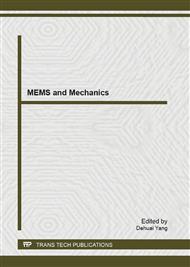[1]
J.B. Wang, N. Zabaras, A Bayesian inference approach to the inverse heat conduction problem, International Journal of Heat and Mass Transfer 47 (2004) 3927-3941.
DOI: 10.1016/j.ijheatmasstransfer.2004.02.028
Google Scholar
[2]
P.C. Tuan, S.C. Lee, W.T. Hou, An efficient on-line thermal input estimation method using Kalman filter and recursive least square algorithm, Inverse Problem in Engineering 5 (1997) 309-333.
DOI: 10.1080/174159797088027665
Google Scholar
[3]
C.C. Ji, P.C. Tuan, H.Y. Jang, A recursive least-squares algorithm for on-line 1-D inverse heat conduction estimation, International Journal of Heat and Mass Transfer 40 (1997) 2081-2096.
DOI: 10.1016/s0017-9310(96)00289-x
Google Scholar
[4]
N. Daouas, M.S. Radhouani, Versión étendue du filtre de Kalman discret appliquée à un problème inverse de conduction de chaleur non linéaire, International Journal of Thermal Sciences 39 (2000) 191-212.
DOI: 10.1016/s1290-0729(00)00239-8
Google Scholar
[5]
T. Liu, B. Liu, P.X. Jiang, Y.W. Zhang, H. Li, A two-dimensional inverse heat conduction problem in estimating the fluid temperature in a pipeline, Applied Thermal Engineering 30 (2010) 1574-1579.
DOI: 10.1016/j.applthermaleng.2010.03.011
Google Scholar
[6]
C.H. Huang, S.P. Wang, A three-dimensional inverse heat conduction problem in estimating surface heat flux by conjugate gradient method, International Journal of Heat and Mass Transfer 42 (1999) 3387-3403.
DOI: 10.1016/s0017-9310(99)00020-4
Google Scholar
[7]
J.A.M. García, J.M.G. Cabeza, A.C. Rodríguez, Two-dimensional non-linear inverse problem heat conduction problem based on the singular value decomposition, International Journal of Thermal Sciences 48 (2009) 1081-1093.
DOI: 10.1016/j.ijthermalsci.2008.09.002
Google Scholar
[8]
K.W. Kim, S.W. Baek, Inverse radiation-conduction design problem in a participating concentric cylindrical medium, International Journal of Heat and Mass Transfer 50 (2007) 2828-2837.
DOI: 10.1016/j.ijheatmasstransfer.2006.10.056
Google Scholar
[9]
S. Deng, Y. Hwang, Applying neural networks to the solution of forward and the inverse heat conduction problems, International Journal of Heat and Mass Transfer 49 (2006) 4732-4750.
DOI: 10.1016/j.ijheatmasstransfer.2006.06.009
Google Scholar
[10]
A.N. Tikhonov, V.Y. Arsenin, Solution of Ill-posed Problems, V.H. Winston & Sons Washington, 1977.
Google Scholar
[11]
O.M. Alifanov, Inverse Heat Transfer Problems, Springer-Verlag, New York, 1994.
Google Scholar
[12]
J.V. Beck, B. Blackwell, C.R. Clair, Inverse Heat Conduction: Ill-posed Problems, Wiley, New York, 1985.
Google Scholar
[13]
S.K. Kim, W.I. Lee, Solution of inverse heat conduction problems using maximum entropy method, International Journal of Heat and Mass Transfer 45 (2002) 381-391.
DOI: 10.1016/s0017-9310(01)00155-7
Google Scholar
[14]
G.R. Liu, J.H. Lee, A.T. Patera, Z.L. Yang, K.Y. Lam, Inverse identification of thermal parameters using reduced-basis method, Computer Methods in Applied Mechanics and Engineering 194 (2005) 3090-3107.
DOI: 10.1016/j.cma.2004.08.003
Google Scholar
[15]
C.S. Liu, A self-adaptive LGSM to recover initial condition or heat source of one-dimensional heat conduction Eq. by using only minimal boundary thermal data, International Journal of Heat and Mass Transfer 54 (2011) 1305-1312.
DOI: 10.1016/j.ijheatmasstransfer.2010.12.013
Google Scholar
[16]
G. Wang, L. Zhu, H. Chen, A decentralized fuzzy inference method for solving the two-dimensional steady inverse heat conduction problem of estimating boundary condition, International Journal of Heat and Mass Transfer 54 (2011) 2782-2788.
DOI: 10.1016/j.ijheatmasstransfer.2011.01.032
Google Scholar
[17]
K.H. Lee, S.W. Baek, K.W. Kim, Inverse radiation analysis using repulsive particle swarm optimization algorithm, International Journal of Heat and Mass Transfer 51 (2008) 2772-2783.
DOI: 10.1016/j.ijheatmasstransfer.2007.09.037
Google Scholar
[18]
M.N. Ozisik, H.R.B. Orlande, Inverse Heat Transfer, Taylor & Francis, New York, 2000.
Google Scholar
[19]
R.T. Lin, Theory and Methods on the Heat Conduction, Tianjin University Press, Tianjin, 1992.
Google Scholar
[20]
S.J. Julier, J.K. Uhlmann, Unscented filtering and nonlinear estimation, Proceedings of the IEEE 92 (2004) 401-422.
DOI: 10.1109/jproc.2003.823141
Google Scholar
[21]
S. Julier, J. Uhlmann, H.F. Durrant-Whyte, A new method for the nonlinear transformation of means and covariances in filters and estimators, IEEE Transactions on Automatic Control 45 (2000) 477-482.
DOI: 10.1109/9.847726
Google Scholar
[22]
E.A. Wan, R. Merwe, The unscented Kalman filter for nonlinear estimation, Adaptive System for Signal Processing, Communications and Control Symposium (2000) 153-158.
DOI: 10.1109/asspcc.2000.882463
Google Scholar
[23]
C. Eberle, C. Ament, The unscented Kalman filter estimation the plasma insulin from glucose measurement, BioSystem 103 (2011) 67-72.
DOI: 10.1016/j.biosystems.2010.09.012
Google Scholar
[24]
J.H. Gove, D.Y. Hollinger, Application of a dual unscented Kalman filter for simultaneous state and parameter estimation in problems of surface-atmosphere exchange, Journal of Geophysical Research 111 (2006) 1-21.
DOI: 10.1029/2005jd006021
Google Scholar
[25]
S. Haykin, Kalman Filter and Neural Networks, John Wiley & Sons, New York, 2001.
Google Scholar
[26]
S. Kolas, B.A. Foss, T.S. Schei, Constrained nonlinear state estimation based on the UKF approach, Computers and Chemical Engineering 33 (2009) 1386-1401.
DOI: 10.1016/j.compchemeng.2009.01.012
Google Scholar


